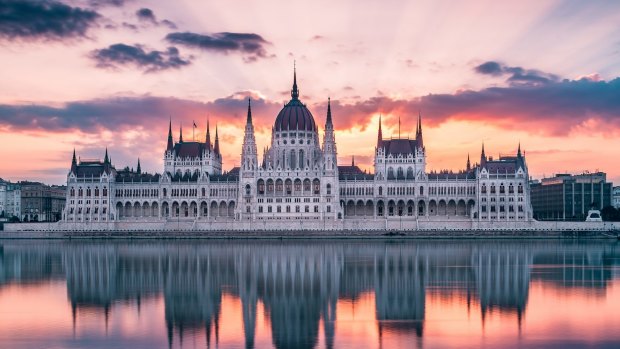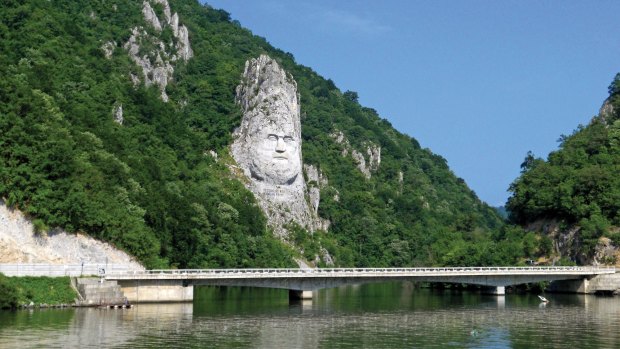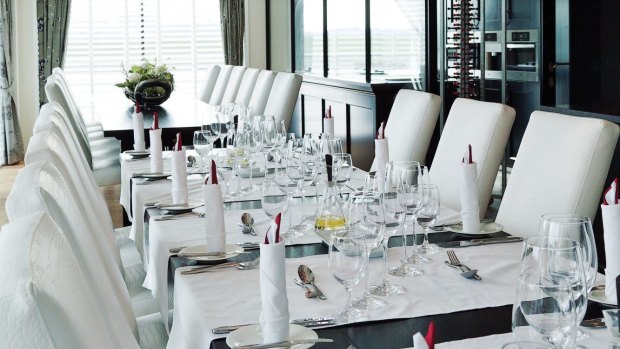This was published 4 years ago
Cruising the Balkans: history, art and culture in Hungary, Serbia and Slovakia
By Sue Williams

A stunning sunrise at the Hungarian Parliament.Credit: iStock
There's a soaring, shell-pocked edifice dominating the skyline of the Croatian city of Vukovar. It was once a restaurant atop a simple water tower, but it's now a striking symbol of the terrible war that ravaged the Balkans in the 1990s. People here will never forget but, by keeping the crumbling tower with its gaping scars from more than 600 artillery hits, they have made sure that everyone who sees it will always remember – as they also strive to forgive.
"Around 5000 people died during the battle for Vukovar," says local Ivana Simunovic of the brutal siege when 2000 defenders of Croatia's independence held off a Serb-dominated Yugoslav army of 36,000 for 87 days with the damage to the city dubbed the worst in Europe since World War II.
"Another 10,000 people were taken away to the camps where they were tortured. My father was a defender and we lost our house in the war. Almost every family lost someone. But today, when we think about it, it's not with hate.

The fabled Iron Gates – a series of towering natural gorges between Serbia and Romania.Credit: APT
"We still have the same mix of nationalities here – Croats and Serbs – that we had before the war, and we now have laws in place to protect minorities. We talk about it openly, teach our kids the lessons of history, and are determined to move on as friends."
The first Croatian president Franjo Tudjman planned to have the tower reconstructed to its original state, but then the country decided to keep it as it is: a haunting memorial.
Sadly, when we think of the Balkans, war is the first thing that comes to mind. And it's not only those battles between the former Yugoslav republics. This region of the world, now more commonly known as south-eastern Europe, sparked World War I, played a huge role in World War II, and then became central to the Cold War.

One of the two restaurants on board.Credit: APT
Today, however, the Balkans are being rediscovered as a beautiful part of Europe with a fascinating history – ancient and modern – spectacular sights, carefully preserved folk cultures of music, dance and handicrafts and enormously welcoming people. And, as a bonus, this area is nowhere near as crowded as Europe upriver.
CHOOSING CRUISING
I've explored the Balkans before, by train and bus. But this time I opt for a 15-day APT Budapest-to-Budapest river cruise along the Danube through the Balkans curated by Traveller Tours , on board the Concerto River Ship, AmaVerde.
The cruise is an experience in itself. The very first time I travelled to Belgrade, then the capital of the former Yugoslavia, I was a penniless student and slept during the overnight train journey on the floor near the toilets which, unfortunately for me, overflowed. I arrived wet and stinking.
This time, I sweep smoothly into the city, these days the capital of Serbia, sitting on my glorious balcony, sipping orange juice, admiring the view of the Danube and the riverbanks, and toasting the travel gods.
The ship itself is the most comfortable I've travelled on, and has a high proportion of crew to passengers, which always helps. For this voyage we have 120 guests – the maximum is only 160 – and 49 crew, with 85 cabins over three of the four decks.
cas well as the main lounge, where pre-breakfast breakfasts, morning tea and afternoon tea are served, and a sun deck with lots of loungers, a pool and spa, walking track and giant chess set. There's also a small spa, gym and shop on board, and what proves to be excellent Wi-Fi throughout the trip.
WONDERFUL WEST
We board our ship in the Hungarian capital Budapest, and I settle in, but immediately after I set out to explore. It's a gorgeous city, with the architectural grandeur of St Petersburg, the cosmopolitan feel of Rome and the lovely little restaurant-lined cobbled squares of Paris.
The Danube slices through the city. The Buda bank has the fairytale turrets and battlements of Fisherman's Bastion and the magnificent Buda Castle, connected to Pest on the other side with a series of bridges, the best-known being the 19th century Chain Bridge. There's the marble St Stephen's Basilica, the splendour of Heroes Square with its monuments and museums and the hot baths and pools.
Meanwhile, the Jewish quarter is full of hip cafes, restaurants and bars, with the fabled "ruin pubs" – pop-up bars operating out of crumbling old deserted buildings – heaving with character, music, life and laughter.
We set sail that first evening, west along the Danube, in the opposite direction to our main Balkans cruise, in order to include some of the highlights upriver. The first is awe-inspiring: we slip silently past the gothic 1902 spires of the Hungarian Parliament Building right on the river, bathed in golden light reflected in the water. The next morning we dock just steps away from the old town of the Slovakian capital Bratislava. It's a charming series of pedestrian-only streets and squares with chocolate-box houses, handsomely restored old buildings and eccentric human-sized bronze statues. One shows a worker clambering out of a manhole, another a Napoleonic soldier leaning over a bench, a third a man jauntily doffing his top hat.
Our last stop on this first section of the cruise is the following day, in the Austrian capital of Vienna. We have a chance to walk around the streets and admire their centrepiece, St Stephen's Cathedral, before hot chocolate and warm chocolate cake in one of the many open-air cafes along the side streets. That evening comes the main highlight of our journey west – a visit to the gloriously opulent baroque Liechtenstein City Palace, once the residence of the Princes von und zu Liechtenstein.
Here guests receive a Traveller Tour exclusive look at the private art collection of Prince von und zu Liechtenstein, which is displayed in several stately rooms and contains some of the most important works in Europe of the last five centuries. They then join the others for a cocktail reception and classical music concert beneath the glittering chandeliers and gold fittings by the Viennese Imperial Orchestra and Mozart Boys Choir.
BALKANS BOUND
On our way back east we receive a talk on Hungary from former Australian ambassador to Hungary and Serbia, Clare Birgin. An expert guest host, she discussed the country's history and its future, before we stopped off again at Budapest and then at Mohacs. We now set sail along the border of Croatia and Serbia – with another onboard talk from Birgin about the history and politics of the former Yugoslavia – before arriving in Belgrade.
A few of us explore the city by bicycle, others on foot, and a few head straight to the nearest brandy distillery. Most still manage to wobble to the top of the Belgrade fortress to see the panoramic views over the city, and to repair for much-needed coffee in the vintage street Skadarlija in the bohemian quarter of the Old Town. The next day is spent on the river, passing by the fabled Iron Gates – the series of towering natural gorges between Serbia and Romania.
Romania's Giurgui is our stop the following day, with a drive through the countryside to the capital Bucharest. It's a bustling city of churches, tree-lined boulevards and buskers. It's dominated, however, by former communist dictator Nicolae Ceausescu's ostentatious Palace of the Parliament, a sobering monolith to his notoriously inflated ego.
Day nine sees us in Bulgaria, driving south to tour one of the country's oldest towns, Veliko Tarnovo, with its fortified walls, cobblestone lanes and fortress, and the World Heritage-listed rock-hewn churches of Ivanovo, high in the Balkan Mountains.
From here we turn back west on the Danube to stop off at Vidin by the border of Serbia, then sail again through the Iron Gates before arriving in Serbia's Novi Sad, and take a hike up the rocky cliffs to the 17th and 18th-century Petrovaradin Fortress and catacombs.
Then it's time for the Croatian side of the Danube, battle-scarred Vukovar, the artworks of a fabulous manor house and local wineries offering, among other varietals, wine served at the coronation of Queen Elizabeth, the wedding of Prince William and Kate Middleton and, most recently, at Prince Harry and Meghan Markle's nuptials.
The final two days are spent back in Hungary, watching displays from the incredible Magyar cowboys of Kalocsa and their incredible horsemanship, and then on a final tour of a city that's begun to feel like home, Budapest.
FIVE HIGHLIGHTS OF THE BALKANS CRUISE
THE IRON GATES
An awe-inspiring natural wonder, the Iron Gates offers glimpses of the old Roman road on the Serbian side, and the memorial plaque Tabula Traiana marking the Roman's presence and, on the Romanian banks, a view of the 43-metre rock carving of the face of Decebalus, the last king of Dacia.
PETROVARADIN FORTRESS
Serbia's Petrovaradin Fortress and catacombs, one of the most impressively sophisticated defence complexes built, is in the shape of a star to make it hard to attack successfully. It even had provision for food barrows and toilets that could be wheeled into the tunnels and then taken out.
BRZICA WINERY
Croatia's picturesque Brzica Winery is located high on the green slopes above where the Danube meets the canals Hagl and Poric, and has 4.5 hectares of plantings, a gold-winning merlot as well as cab sav and vranac.
PALACE OF THE PARLIAMENT
Nicolae Ceausescu's massive Palace of the Parliament in Romania's Bucharest, is a monstrosity of marble, gold and hubris.
HORSEMEN OF KALOCSA
Hungary's Puszta Show stars the horsemen of Kalocsa who can gallop at speed with a glass of water on their heads and not spill a drop, instruct their horses to lie down and sit – which they did during battle to avoid detection – and stand on the rears of two horses as a brace of 10 race around an arena at full pelt.
TRIP NOTES
FLY
Qantas, Qatar Airways and Emirates all fly to Budapest with only one stop, in either Dubai or Doha. See qantas.com/au; qatarairways.com/en; emirates.com/au
CRUISE
APT's 15-day Budapest-to-Budapest Voyage Through the Balkans includes sightseeing, guides, meals and most drinks on board, Wi-Fi, port charges and transfers. From $8995 a person twin-share. Traveller Tours are curated for readers of The Sydney Morning Herald and The Age by the editors. Each bespoke itinerary combines their unrivalled travel knowledge with that of our trusted tour operator partners and offers the company of expert hosts. See aptouring.com.au
MORE
Sue Williams was an expert guest host and travelled as a guest of APT.
Sign up for the Traveller Deals newsletter
Get exclusive travel deals delivered straight to your inbox. Sign up now.